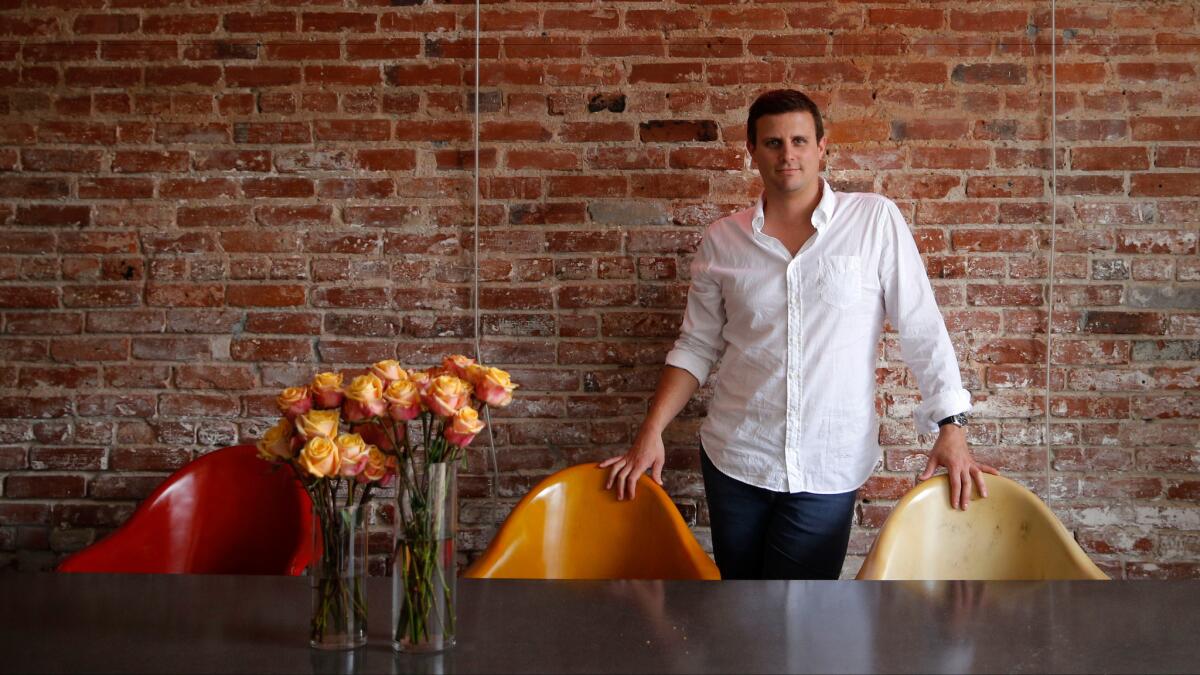Dollar Shave Club built a billion-dollar brand with bizarre videos

Gillette, the largest U.S. razor brand, has advertised its blades as cutting-edge technology with images of fighter jets and names such as Mach and Fusion.
Dollar Shave Club, an industry upstart, has made ads featuring dancing bears and its chief executive describing his bodily functions.
This week, Dollar Shave Club proved the value of this type of irreverent marketing when Unilever announced it would acquire the Venice start-up for $1 billion.
Dollar Shave Club, which operates a subscription service for affordable razors, first gained attention in 2012 with an online video starring its co-founder and chief executive, Michael Dubin.
While expounding on the virtues of his company’s blades, Dubin appeared in a montage of quirky scenes: swinging a machete, riding a toy wagon and dancing while dollar bills rained down. The video proved a massive hit, leading to 12,000 new customers in the first 48 hours.
Such branding, which speaks especially to twenty- and thirty-somethings who often tune out more traditional advertising, is key to why Unilever paid such a hefty price for the young company, experts said.
“This really resonated with millennials,” said Miro Copic, a branding expert and marketing lecturer at San Diego State. “They used a type of humor that would play well for people starting their grooming process, post college into young professionals.”
Grooming companies are especially interested in young men because they are easier to woo than older shoppers, who are more likely devoted to the mainstay brands Gillette and Schick, analysts said. Men also tend to be more brand loyal than women when it comes to personal care items; once they find one that works, they tend to stick with it.
Its efforts to lure younger customers — and distance itself from more taciturn competitors — are evident in a video titled “Let’s Talk About #2.” The ad opens with a shot of Dubin sitting on a toilet, ready to plug bathroom wipes called One Wipe Charlies.
“I don’t have time to jump into a shower after a messy #6,” Dubin declares in his typical deadpan. “I’m an executive now.”
After building buzz with online videos, Dollar Shave Club turned some of its $160 million in venture capital funding toward more traditional advertising channels. This year, it aired a Super Bowl ad — featuring a filthy talking razor blade — that cost an estimated $4.9 million.
As the company has grown, its ads have continued to portray an image unlike its rivals. Procter & Gamble’s Gillette brand frequently runs commercials emphasizing its razors’ high-tech functionality, often closing with a shot of a half-nude man giving himself a smooth shave.
In the direct-to-consumer category, its main competitor is Harry’s, a start-up that emphasizes the quality of its products and the luxuriousness of its shaving experience.
But even Harry’s seems to have taken a page out of the Dollar Shave Club playbook. In its first TV spot last year, the company poked fun at the complicated “gimmicks” offered by the “old guard” razor companies.
That’s something that Dollar Shave Club has been doing since the beginning, experts said.
The company staked out unique territory by acknowledging that razors are essentially commodities, experts said. What Dollar Shave Club promised was a lower price, added convenience and a sort of nod-and-wink inclusion into a brotherhood that understands razors are simply razors.
“It was almost like starting a club,” said Britt Bulla, senior director of strategy at branding firm Siegel+Gale. “If you were in were in it, you were in the know.”
And if you were in the know, you just might share those quirky ads on social media — furthering the company’s reach.
Unilever probably saw ways that Dollar Shave Club could complement its men’s grooming brand Axe, which is also geared toward a younger audience (its ads revolve around the many ways its products attract women).
To grow Dollar Shave Club, the company will have to figure out how to translate its humor to multiple countries and deliver its offbeat message without always having its chief executive front and center.
“He’s going to be important to maintain continuity and the irreverence of the brand,” Copic said. “Ultimately it’s a question of allowing the brand to stand on its own.”
ALSO
Why Dollar Shave Club invests in unscripted customer service
Why Silicon Valley venture capital firms are funding online retailers like Dollar Shave Club
The Silicon Valley entrepreneur moving black-hair products out of the ethnic aisle







